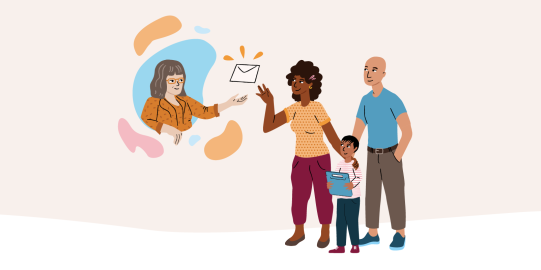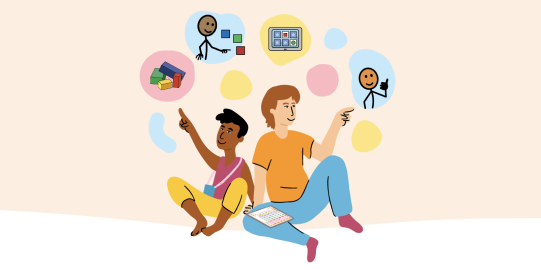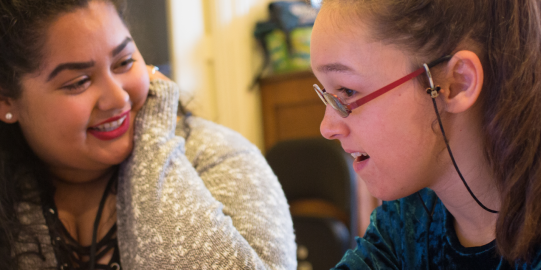When professionals teach parents how to “work” with their child at home, a lot of research says this helps improve the child’s communication and social interactions.
When does it work? When it is embedded into an existing family activity or routine.
There is also research that tells us when this doesn’t work.
But when doesn’t it work? When it’s one more thing to remember to do.
Parents will sacrifice and do their best, especially if an “expert” or “professional” has asked them to, even if that means doing exercises for trunk control and then hand strengthening, along with oral motor exercises and, on top of that, model core words during dinner. It is a lot! With so many add-ons, is it any wonder the child does not make the gains they were all hoping for? And other things are sacrificed too.
When parents sacrifice family time, self-care or time with their partner, it creates disruption instead of positive outcomes. Even if it is not fun and doesn’t fit into existing family routines, parents will still sacrifice and do their best to get it done.*
So parents, please take time to consider whether your family has the capacity before agreeing to add therapy or classroom activities into your family routines.
If it has the potential to be too much, you can say, “This is not the right time for our family to take on that project, task, or activity.”
My colleague, Patty, discovered that her relationship with her oldest son was straining during the Covid 19 quarantine. He is an AAC user, and she was responsible for all of his schoolwork and therapy. Her decision to drop all therapies and only complete the minimally-required schoolwork was the correct one.
If you take on too much and spend too much time being a “therapist” or “teacher” to your child, it will create conflict between you and your child’s team. You may begin to resent their expectations or feel the heavy responsibilities. You could start to feel sadness, missing the time you could be spending being a parent. This could affect how you collaborate with others.
And then, there are inappropriate requests from the school team that you should decline immediately. Explain that it is inappropriate for you, as a parent, to sabotage or mislead your child.
Examples of teacher/therapist tasks NOT to take on:
- Your child is talking too much about Minecraft at school, so the school team would like to remove the folder from his AAC and ask you to redirect him when he talks about Minecraft at home.
- The school team would like you to offer your child something you know they don’t like, so they have to protest.
- The school team asks you to try pretending you don’t understand what your child is telling you. They will have plenty of real communication breakdowns.
- The school team asks you to put their favorite snack where they can see it but not reach it so they can ask you for it.
It’s important to learn and practice how to use AAC
At school, your child will have a team to oversee their education and how AAC fits into their school day. You and your child are members of that team. As a member of the AAC team, you will need AAC training. It is important that you get this AAC training because we know that when parents receive AAC training, good things happen:
Children use their AAC more
Parents are more confident using AAC
And from personal experience, I know you and your child will enjoy a stronger connection.
These are all excellent reasons to pursue training and learn AAC best practices and how to support your child to become a confident communicator.
Some parents dive right in and don’t come up for air for weeks.
Others start, struggle, and then give up.
I was one of the moms who dove into learning all I could. And if I could go back, I wish I knew this:
While learning how to become a supportive communication partner for your child, you need to protect your relationship with your child.
Four ways to start to protect and nurture your parent/child bond

Make it your North star
The North Star is a marker in the northern sky. It is used to guide and lead people to their destination. It is also a symbol of hope. Let protecting the bond between you and your child be your North Star.
When it comes time to make a decision, you use this direction for guidance. Will this decision positively or negatively affect my relationship with my child? How does it affect our family?

Change your inner voice
Change the words you say to yourself in your own head - your self-talk. For me, it was a big shift when I stopped saying, “I have to take Josh to meet his new teacher. I have to help Josh practice writing his name. I can’t because that’s when I have to get Josh dressed for school.” I started thinking to myself; I get to take Josh to meet his new teacher. I get to help Josh practice his spelling words. And I can’t because that’s when I get to help Josh get dressed for school. I see my time with Josh as a gift. This changed my world. And how I talk to myself.

Consider what you say to others
Borrowing from how I changed my self-talk, I also started paying attention to how I talk about Josh with others. I am not ashamed or embarrassed. I stick to the facts. I protect Josh’s dignity and privacy at all times.
You decide what to say and to whom. You don’t have to give details. And if someone asks a question that is out of line, pause, take a deep breath, and very slowly say, “Why would you ask me a question like that?”
Examples of inappropriate questions I was asked when Josh was in school:
- Don’t you want him to do well on the test?
- Why won’t you take responsibility for his behavior at school?
- Does he still wear a diaper?
- How long is he expected to live?
- Will he ever learn to talk?
- Will he live in a group home when you die?
If you feel pushed to say more than you are comfortable with . . . say, “I am not comfortable with this conversation.”
If you are worried you will get emotional or find it hard to be positive at that moment . . say, “This isn’t a good time to talk about this topic.”

Your actions speak volumes
How you interact with your child around other people influences their interaction with your child. Years ago, when Josh was still small enough to sit in the buggy cart at the grocery store, we were in the checkout lane. Like most of you, I have a few games that I played with Josh when we were waiting. I would sing a little song and sign along. Josh would do the same. The itsy bitsy spider was a favorite. People would always be amazed that Josh could sign along with me. Then I would ask Josh what song should we sing next, and using sign, he would tell me. A few years later, he was using his AAC device to communicate with me. People would be astounded at the technology and Josh’s ability to communicate. The child they watched flapping, squealing, or hollering was a human being communicating with his mother.
I know how hard it can be. I needed to hear from another parent that it was okay to say no or not now. You are doing the right things. Prioritize the relationships in your child’s life - the most important being the relationship between you and your child.




